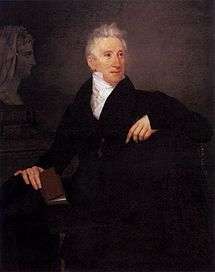Leopoldo Cicognara

Portrait by Ludovico Lipparini (1825).
Count Leopoldo Cicognara (17 November 1767, in Ferrara – 5 March 1834) was an Italian archaeologist and writer on art.
Biography
Cicognara resided for some years at Rome, where he devoted himself to painting and the study of antiquities and galleries; later he visited Naples and Sicily, and published at Palermo one of his first works, a poem of no merit. After exploring the island, he betook himself to Florence, Milan, Bologna and Venice, acquiring a complete archaeological knowledge of these and other cities.
In 1795, he took up his abode at Modena and was for twelve years engaged in politics, becoming a member of the legislative body, a councillor of state, and minister plenipotentiary of the Cisalpine Republic at Turin. Napoleon decorated him with the Iron Crown; and in 1808 he was made president of the Accademia di Belle Arti di Venezia, a post in which he did good work for a number of years.
In 1808, his treatise Del bello regionamenti appeared, dedicated in glowing terms to Napoleon. This was followed by his magnum opus, the Storia della scultura dal suo risorgimento in Italia al secolo di Napoleone, in the composition of which he had been encouraged and advised by Wilhelm Schlegel. The book was designed to complete the works of Winckelmann and D'Agincourt, and is illustrated with 180 plates in outline.
In 1814, after the fall of Napoleon, Cicognara was patronized by Francis I of Austria, and between 1815 and 1820 published, under the auspices of that sovereign, his Fabbriche più cospicue di Venezia, two superb folios, containing some 150 plates. Charged by the Venetians with the presentation of their gifts to the Princess Caroline Augusta of Bavaria at Vienna, Cicognara added to the offering an illustrated catalogue of the objects it comprised; this book, Omaggio delle Provincie Venete alla maestri Carolina Augusta, has since become of great value to the bibliophiles.
Reduced to poverty by these splendid editorial speculations, Cicognara contrived to alienate the imperial favor by his political opinions. He left Venice for Rome; his library was offered for sale; and, in 1821 he published at Pisa a catalogue, rich in bibliographical lore, of this fine collection, the result of thirty years of loving labor, which, in 1824, was purchased en bloc by Pope Leo XII, and added to the Vatican library. The other works by Cicognara are the Memorie storiche de litterati ed artisti Ferraresi (1811); the Vite de' più insigni pittori e scultori Ferraresi, MS.; the Memorie spettanti alla storia della calcografia (1831); and a large number of dissertations on painting, sculpture, engraving and other kindred subjects. Cicognara's work in the academy at Venice, of which he became president in 1808, had important results in the increase in number of the professors, the improvement in the courses of study, the institution of prizes, and the foundation of a gallery for the reception of Venetian pictures. In 1833, he was elected into the National Academy of Design as an Honorary Academician.
Philipp Fehl and Raina Fehl were the directors of The Leopoldo Cicognara Program at the University of Illinois Library, dedicated to the study and promulgation of literary sources in the history of art, 1987-2007. They cataloged the collection of work found in the Fondo Cicognara at the Vatican Library.
References
 This article incorporates text from a publication now in the public domain: Chisholm, Hugh, ed. (1911). "Cicognara, Leopoldo". Encyclopædia Britannica. 6 (11th ed.). Cambridge University Press. pp. 360–361.
This article incorporates text from a publication now in the public domain: Chisholm, Hugh, ed. (1911). "Cicognara, Leopoldo". Encyclopædia Britannica. 6 (11th ed.). Cambridge University Press. pp. 360–361.
External links
Works
- Conte Leopoldo, Cicognara (1823). Storia della Scultura dal suo Risorgimento in Italia Fino al Secolo di Canova. Second Edition, Second Volume. Fratelli Giaccheti, Prato.
- 3rd Volume, 1823.
- 4th Volume, 1823.
- 5th Volume, 1825.
- 6th Volume, 1824.
- 7th Volume, 1924.
| Preceded by - |
President of Ateneo Veneto 1811-17 |
Succeeded by Francesco Aglietti |